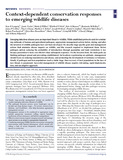| dc.contributor.author | Langwig, Kate E. | |
| dc.contributor.author | Voyles, Jamie | |
| dc.contributor.author | Wilber, Mark Q. | |
| dc.contributor.author | Frick, Winifred F. | |
| dc.contributor.author | Murray, Kris A. | |
| dc.contributor.author | Bolker, Benjamin M. | |
| dc.contributor.author | Collins, James P. | |
| dc.contributor.author | Cheng, Tina L. | |
| dc.contributor.author | Fisher, Matthew C. | |
| dc.contributor.author | Hoyt, Joseph R. | |
| dc.contributor.author | Lindner, Daniel L. | |
| dc.contributor.author | McCallum, Hamish I. | |
| dc.contributor.author | Puschendorf, Robert | |
| dc.contributor.author | Rosenblum, Erica Bree | |
| dc.contributor.author | Toothman, Mary | |
| dc.contributor.author | Willis, Craig K. R. | |
| dc.contributor.author | Briggs, Cheryl J. | |
| dc.contributor.author | Kilpatrick, A. Marm | |
| dc.date.accessioned | 2016-11-28T22:24:08Z | |
| dc.date.available | 2016-11-28T22:24:08Z | |
| dc.date.issued | 2015 | |
| dc.identifier.citation | Langwig, Kate E., et al. "Context-dependent conservation responses to emerging wildlife diseases." Frontiers in Ecology and the Environment 2015; 13(4): 195–202. DOI:10.1890/140241. | en_US |
| dc.identifier.issn | 1540-9295 | |
| dc.identifier.uri | http://hdl.handle.net/10680/1251 | |
| dc.description.abstract | Emerging infectious diseases pose an important threat to wildlife. While established protocols exist for combating outbreaks of human and agricultural pathogens, appropriate management actions before, during, and after the invasion of wildlife pathogens have not been developed. We describe stage-specific goals and management actions that minimize disease impacts on wildlife, and the research required to implement them. Before pathogen arrival, reducing the probability of introduction through quarantine and trade restrictions is key because prevention is more cost effective than subsequent responses. On the invasion front, the main goals are limiting pathogen spread and preventing establishment. In locations experiencing an epidemic, management should focus on reducing transmission and disease, and promoting the development of resistance or tolerance. Finally, if pathogen and host populations reach a stable stage, then recovery of host populations in the face of new threats is paramount. Successful management of wildlife disease requires risk-taking, rapid implementation, and an adaptive approach. | en_US |
| dc.description.sponsorship | "Funding was provided by the US National Science Foundation (grants EF-0914866, DGE-0741448, DEB-1115069, DEB-1336290) and the National Institutes of Health (grant 1R010AI090159)." | en_US |
| dc.description.uri | https://esajournals.onlinelibrary.wiley.com/doi/abs/10.1890/140241 | |
| dc.language.iso | en | en_US |
| dc.publisher | Ecological Society of America | en_US |
| dc.rights | info:eu-repo/semantics/openAccess | |
| dc.subject | Wildlife diseases | en_US |
| dc.title | Context-dependent conservation responses to emerging wildlife diseases | en_US |
| dc.type | Article | en_US |
| dc.identifier.doi | 10.1890/140241 | |

